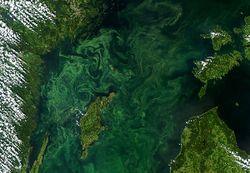Difference between revisions of "Case studies eutrophication"
(→Human health impacts of eutrophication) |
|||
| Line 27: | Line 27: | ||
====References==== | ====References==== | ||
<references/> | <references/> | ||
| + | |||
| + | ==Recreational and aesthetic impacts of eutrophication== | ||
Revision as of 08:29, 17 April 2013
Contents
Ecological impacts of eutrophication (case study: Eutrophication and dead zones)
Introduction
Dead zones are very low oxygen areas (hypoxic) in the ocean where marine life including fish, crabs and clams cannot survive. In the 1970s oceanographers began noting increased instances of dead zones. A 2008 study counted 405 dead zones worldwide[1]. Hypoxia is a natural phenomenon that occurs periodically in coastal waters around the world. During the last 50 years however, increases in key pollutants from human activities on land have thrown many coastal ecosystems out of balance, resulting in expanded dead zone regions.
Causes and consequences
Aquatic and marine dead zones can be caused by an increase in chemical nutrients (primarily nitrogen and phosphorus) in the water known as eutrophication. Major nutrient sources come from human activities such as the use of fertilizers in agriculture and the burning of fossil fuels. These nutrients lead to a rapid increase of the density of certain types of phytoplankton resulting in algal blooms. The organic matter prouced by these phytoplankton species at the surface of the ocean sinks to the bottom (the benthic zone) where bacteria break it down. The bacteria use oxygen and give off carbon dioxide during this breakdown. Fish and mobile invertebrates can migrate out of hypoxic areas. Plants and animals that are slow moving or attached to the bottom (seagrass, worms and clams) cannot escape from the dangers of hypoxic waters and will die.
The largest dead zone worldwide is the Baltic Sea[1]. Overfishing of Baltic cod has greatly intensified the problem. Cod eat sprats, a small, herring-like species that eat microscopic zooplankton that in turn eat the algae. So, fewer cods and an explosion of zooplankton-eating sprats means more algae and less oxygen- a vicious cycle develops [2].
Solutions
The main goal in reducing dead zones is to keep fertilizers on the land and out of coastal waters. The Black Sea dead zone largely disappeared between 1991 and 2001 after fertilizers became too costly to use following the collapse of the Sovjet Union and the demise of eastern European economies. Nutrients loads entering the sea where therefore considerably reduced. Fishing has again become a major economic activity in the region.
However, our ocean ecosystems are fragile and the combined threats of climate change, overexploitation, pollution and habitat loss,all mostly caused by human activity, are undermining the sustainability. Expanded dead zones caused by global warming will remain for thousands of years and have harmful long-term effects on ocean ecosystems.
References
Human health impacts of eutrophication
The consumption of shellfish (e.g. mussels, clams) is one of the most common ways for algal toxins to impact human health. Marketable shellfish are generally considered to be safe, but in spite of these precautions, there are known illnesses.
One dramatic incident occurred in 1990 when six fishermen almost died from eating mussels during a fishing trip on Georges Bank, a productive offshore finfish and shellfish area 100 miles east of Cape Cod, MA. After a hard day of fishing, the fishermen settled down in the ship's galley to eat a pot of steamed mussels that they had inadvertently caught in their nets. The Captain, who had joined the meal later than the rest of the crew, witnessed his fellow fishermen become incapacitated due to the paralytic effects of the toxin. He himself also became ill, but was capable of sending an urgent radio message to the US Coast Guard. The Coast Guard airlifted the men to the nearest hospital located on Nantucket Island, MA where they were treated using respiratory therapy to sustain their breathing and prevent them from dying due to paralysis of the lungs. Fortunately, all the men recovered and were back fishing within a few weeks. The event, presumably caused by a massive Alexandrium [1] bloom transported offshore from areas along the northeast coast, closed the surf clam industry on Georges Bank to further harvest.
References
- ↑ WoRMS (2012). Alexandrium Halim, 1960 emend. Balech, 1989. In: Guiry, M.D. & Guiry, G.M. (2012). AlgaeBase. World-wide electronic publication, National University of Ireland, Galway. Accessed through: World Register of Marine Species at http://www.marinespecies.org/aphia.php?p=taxdetails&id=109470
